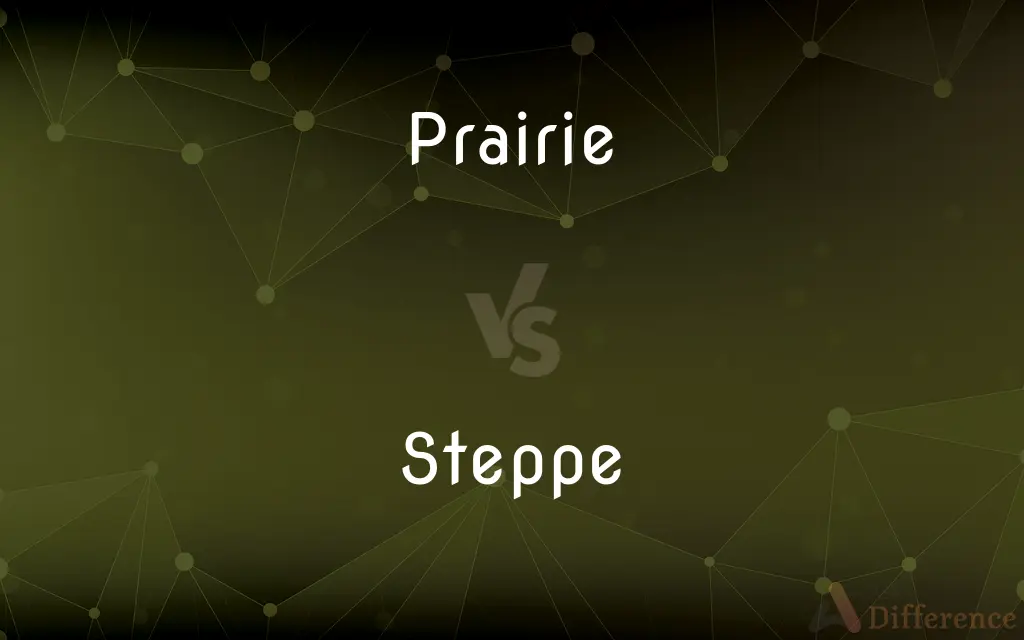Prairie vs. Steppe — What's the Difference?
By Maham Liaqat & Urooj Arif — Updated on February 28, 2024
Prairies are ecosystems characterized by grasslands with few trees, mainly found in North America, thriving in areas with moderate rainfall. Steppes are similar grassland ecosystems located in Eurasia, adapted to semi arid climate with less precipitation.

Difference Between Prairie and Steppe
Table of Contents
ADVERTISEMENT
Key Differences
Prairies and steppes are both vast expanses of grassland, but their geographical locations and climatic conditions distinguish them. Prairies, abundant in North America, receive more rainfall, which supports a wider variety of grasses and sometimes even trees, especially near water sources or in protected areas. Steppes, on the other hand, stretch across parts of Eurasia, including areas like Mongolia and the Russian Plain, where the dryer climate limits plant diversity to hardier grasses and shrubs, with trees being notably scarce.
The soil composition also differs between the two, with prairie soils often being more fertile and rich in organic matter, thanks to the denser vegetation and higher precipitation. This makes prairies suitable for agriculture once tilled. Steppe soils, while still fertile, are typically less rich due to the lower precipitation and sparser vegetation, making them less ideal for intensive farming but suitable for grazing and nomadic pastoralism.
Biodiversity in prairies includes a wide range of grass species, wildflowers (known as forbs), insects, birds, and large mammals like bison. Steppes host a similar variety of life, though the species composition varies due to the different climate; animals adapted to open, dry areas, such as saiga antelope, are more common.
Human impact on these ecosystems has been significant, with both prairies and steppes facing threats from agricultural expansion, urbanization, and climate change. Conservation efforts are underway in many regions to preserve the unique biodiversity and landscape of these grasslands.
Both prairies and steppes have shaped the lifestyles and histories of the peoples living among them, from the Indigenous tribes of the Great Plains to the nomadic cultures of Central Asia. These ecosystems have influenced settlement patterns, economies, and cultural narratives, highlighting their importance beyond their environmental roles.
ADVERTISEMENT
Comparison Chart
Location
Primarily in North America.
Found in Eurasia.
Climate
Moderate rainfall, supporting diverse plant life.
Semi-arid, with less precipitation and fewer trees.
Soil
Rich and fertile, ideal for agriculture.
Less organic matter, more suited to grazing.
Vegetation
Diverse grasses and wildflowers, with occasional trees.
Dominated by grasses and shrubs, with rare trees.
Biodiversity
Includes large mammals like bison, a variety of birds, and insects.
Adapted to dry conditions, with species like saiga antelope.
Human Impact
Affected by agriculture, urbanization, and climate change.
Similarly impacted, with significant areas converted for grazing.
Cultural Significance
Influenced Indigenous and settler cultures in North America.
Shaped the nomadic and pastoral lifestyles in Eurasia.
Compare with Definitions
Prairie
Characterized by fertile soils, often converted into farmland.
Much of the prairie has been tilled for agricultural purposes.
Steppe
Cultural importance in the history of nomadic peoples.
The steppe has been a crossroads of civilizations throughout history.
Prairie
Found mainly in the interior of North America.
The Great Plains are a vast prairie region.
Steppe
Home to specialized fauna adapted to open, dry landscapes.
The saiga antelope is a unique species of the steppe.
Prairie
A grassland ecosystem with moderate rainfall, rich in species diversity.
The American prairie is home to hundreds of grass and wildflower species.
Steppe
Soil is fertile but less rich than prairie soils, supporting grazing.
Steppe lands support traditional pastoral nomadism.
Prairie
Influences local climate and weather patterns.
Prairies play a role in creating local weather phenomena.
Steppe
A grassland region with semi-arid conditions, less diverse in vegetation.
The Eurasian steppe stretches from Ukraine to Mongolia.
Prairie
Supports large mammals and a variety of birds.
Prairies once roamed with vast herds of bison.
Steppe
Characterized by wide, open spaces and significant temperature extremes.
Steppes experience hot summers and cold winters.
Prairie
Prairies are ecosystems considered part of the temperate grasslands, savannas, and shrublands biome by ecologists, based on similar temperate climates, moderate rainfall, and a composition of grasses, herbs, and shrubs, rather than trees, as the dominant vegetation type. Temperate grassland regions include the Pampas of Argentina, Brazil and Uruguay, and the steppe of Ukraine, Russia and Kazakhstan.
Steppe
In physical geography, a steppe is an ecoregion characterized by grassland plains without trees apart from those near rivers and lakes. Steppe biomes may include: the montane grasslands and shrublands biome the temperate grasslands, savannas and shrublands biomeThe prairie of North America (especially the shortgrass and mixed prairie) is an example of a steppe, though it is not usually called such.
Prairie
An extensive flat or rolling area dominated by grasses, especially the grasslands that once covered much of central North America.
Steppe
A large area of flat unforested grassland in south-eastern Europe or Siberia.
Prairie
An extensive area of relatively flat grassland with few, if any, trees, especially in North America.
Steppe
A vast semiarid grass-covered plain, as found in southeast Europe, Siberia, and central North America.
Prairie
An extensive tract of level or rolling land, destitute of trees, covered with coarse grass, and usually characterized by a deep, fertile soil. They abound throughout the Mississippi valley, between the Alleghanies and the Rocky mountains.
From the forests and the prairies,From the great lakes of the northland.
Steppe
The grasslands of Eastern Europe and Asia. Similar to (North American) prairie and (African) savanna.
Steppe
One of the vast plains in Southeastern Europe and in Asia, generally elevated, and free from wood, analogous to many of the prairies in Western North America. See Savanna.
Common Curiosities
Why are there fewer trees in steppes compared to prairies?
The semi-arid climate of steppes results in less rainfall, which limits tree growth and favors grasses and shrubs adapted to dryer conditions.
What conservation efforts are in place for these ecosystems?
Efforts include establishing protected areas, sustainable agriculture practices, and restoration projects to preserve native vegetation and wildlife.
Can prairies and steppes be found outside North America and Eurasia?
Similar grassland ecosystems exist worldwide but are often known by other names, such as savannas in Africa, which differ in climate and biodiversity.
Are prairies or steppes more suitable for farming?
Prairies, with their richer soils and more moderate climate, are generally more suitable for farming than the drier, less fertile steppes.
Can prairies and steppes recover from agricultural development?
Recovery is possible through restoration efforts, though it requires significant time and resources to restore native vegetation and soil health.
What role do prairies and steppes play in the carbon cycle?
They act as carbon sinks, with their vegetation and soils absorbing and storing carbon, helping to mitigate climate change.
How do human activities impact prairies and steppes?
Agriculture, urbanization, and overgrazing threaten both ecosystems, leading to habitat loss, soil degradation, and reduced biodiversity.
How does climate change affect prairies and steppes?
Climate change can alter precipitation patterns and temperature, impacting plant and animal species, and increasing the vulnerability of these ecosystems.
What makes prairies and steppes important for biodiversity?
They provide habitats for a wide range of species, many of which are adapted to the unique conditions of these grasslands, contributing to global biodiversity.
How do cultural perceptions of prairies and steppes differ?
Cultural perceptions are shaped by historical interactions; in North America, prairies are often associated with frontier history, while in Eurasia, steppes are linked to nomadic heritage and the Silk Road.
Share Your Discovery

Previous Comparison
Neural vs. Neuronal
Next Comparison
Primal vs. PrimordialAuthor Spotlight
Written by
Maham LiaqatCo-written by
Urooj ArifUrooj is a skilled content writer at Ask Difference, known for her exceptional ability to simplify complex topics into engaging and informative content. With a passion for research and a flair for clear, concise writing, she consistently delivers articles that resonate with our diverse audience.












































